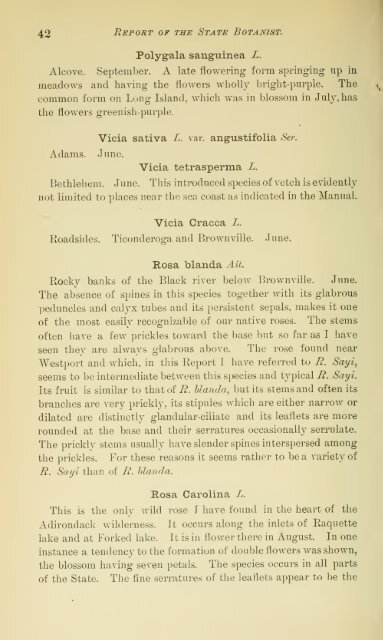Annual Report of the State Botanist 1892 - MykoWeb
Annual Report of the State Botanist 1892 - MykoWeb
Annual Report of the State Botanist 1892 - MykoWeb
You also want an ePaper? Increase the reach of your titles
YUMPU automatically turns print PDFs into web optimized ePapers that Google loves.
42<br />
<strong>Report</strong> <strong>of</strong> <strong>the</strong> <strong>State</strong> <strong>Botanist</strong>.<br />
Polygala sanguinea L.<br />
Alcove. September. A late flowering form springing up in<br />
meadows and having <strong>the</strong> flowers wholly bright-purple. The<br />
common form on Long Island, which was in blossom in July, has<br />
<strong>the</strong> flowers greenish-purple.<br />
Adams. June.<br />
Vicia sativa L. var. angustifolia Ser.<br />
Vicia tetrasperma L.<br />
Bethlehem. June. This introduced species <strong>of</strong> vetch is evidently<br />
not limited to places near <strong>the</strong> sea coast as indicated in <strong>the</strong> Manual.<br />
Vicia Cracca L.<br />
Eoadsides. Ticonderoga and Brownville. June.<br />
Rosa blanda Ait.<br />
Rocky banks <strong>of</strong> <strong>the</strong> Black river below Brownville. June.<br />
The absence <strong>of</strong> spines in this species toge<strong>the</strong>r with its glabrous<br />
i:)eduncles and calyx tubes and its persistent sepals, makes it one<br />
<strong>of</strong> <strong>the</strong> most easily recognizable <strong>of</strong> our native roses. The stems<br />
<strong>of</strong>ten have a few prickles toward <strong>the</strong> base but so far as I have<br />
seen <strong>the</strong>y are always glabrous above. The rose found near<br />
Westport and which, in this <strong>Report</strong> I have referred to R. Sayi,<br />
seems to be intermediate between this species and typical R. Sayi.<br />
Its fruit is similar to that <strong>of</strong> R. hlanda, but its stems and <strong>of</strong>ten its<br />
branches are very prickly, its stipules which are ei<strong>the</strong>r narrow or<br />
dilated are distinctly glandular-ciliate and its leaflets are more<br />
rounded at <strong>the</strong> base and <strong>the</strong>ir serratures occasionally serrulate.<br />
The prickly stems usually have slender spines interspersed among<br />
<strong>the</strong> prickles. For <strong>the</strong>se reasons it seems ra<strong>the</strong>r to be a variety <strong>of</strong><br />
R. Sayi than <strong>of</strong> R. hlanda.<br />
Rosa Carolina L.<br />
This is <strong>the</strong> only wild rose I have found in <strong>the</strong> heart <strong>of</strong> <strong>the</strong><br />
Adirondack wilderness. It occurs along <strong>the</strong> inlets <strong>of</strong> Raquette<br />
lake and at Forked lake. It is in flower <strong>the</strong>re in August. In one<br />
instance a tendency to <strong>the</strong> formation <strong>of</strong> double flowers was shown,<br />
<strong>the</strong> blossom having seven petals. The species occurs in all parts<br />
<strong>of</strong> <strong>the</strong> <strong>State</strong>. The fine serratures <strong>of</strong> <strong>the</strong> leaflets appear to be <strong>the</strong>
















